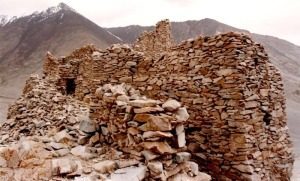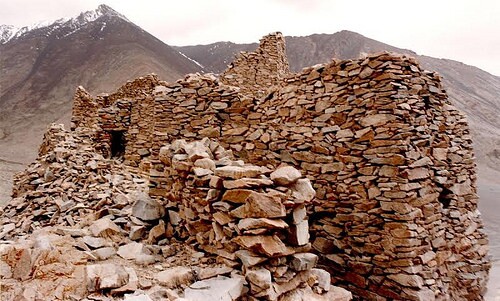
Before Buddhism reigned supreme in the high tableland of the Tibetan Plateau, there prevailed another spiritual regime, one ruled by a pantheon of gods with one named Gekhö at the helm. These gods, unlike the nontheistic, philosophically-oriented religion of Buddhism, were closely aligned to the stars, moon, sun, planets, and celestial dragons. They were the deities of the ancient kingdom of Zhang Zhung, an advanced culture that dominated the western and northern region of Tibet known as Upper Tibet. Zhang Zhung had its beginnings long before the Imperial Roman Empire reached its peak, and it dominated western Tibet while Alexander the Great marched across the lower plains and valleys of the known world far to its south and west.
“Upper Tibet of 1200 to 2500 years ago possessed a culture as advanced as any of its neighbors, at least in certain aspects,” says author and archaeologist John Bellezza. “By many measures—monumental architecture, social complexity, irrigated agriculture, mining, and inter-regional trade—this was a civilized order, a constituent part of the wider civilization of the Tibetan Plateau.”
For more than two decades, University of Virginia Tibet Center archaeologist and historian John Vincent Bellezza has been exploring highland central Asia, going places where few archaeologists and explorers have ventured. He has investigated and documented scores of monumental sites, rock art, castles, temples, residential structures, and other features on the desolate reaches of the Tibetan Plateau, building a knowledge base on a vast archaic civilization and an ancient religion that flourished long before Buddhism emerged and dominated this otherwise comparatively sparsely populated high altitude region.
“It was in prehistory [before the Tibetan empire and Tibetan Buddhism] that Upper Tibet reached its zenith in terms of settlement building and population density,” Bellezza continues. “This was a remarkable feat when we consider the great elevation [averaging more than 15,000 feet], geographic isolation and marginal climate of the region.”
Some scholars have suggested that Zhang Zhung constituted the historical basis for the mythical legend of Shambhala, the inspiration for the fictional Shangri-La, the popular, paradisiacal utopian society nestled within the Himalayans described in the 1933 novel Lost Horizons. And though far less fantastic, the reality of the Zhang Zhung civilization still invites the imagination.
In his books and other writings, Bellezza describes this archaic civilization as flourishing from about 500 BC to 625 AD (Tibet’s Iron Age and aftermath) and encompassing most of the western and northwestern regions of the Tibetan Plateau. Mastering an ancient technology base not normally attributed to peoples of this region in the popular perception, the people of Iron Age Zhang Zhung, according to Bellezza, built citadels, elite stone-corbelled residential structures, temples, necropolises featuring stone pillars, sported metal armaments and a strong equestrian culture, established links with other cultures across Eurasia, and exhibited a relatively uniform and standardized cultural tradition rich in ritualistic religious practice, where kings and priests dominated the highest rungs of power. These are all characteristics of stratified, centralized and developed societies most often associated with the more southerly, lower-altitude Old World Bronze and Iron Age civilizations and the advanced civilizations of Mesoamerica and South America. The supporting findings on the Tibetan landscape, when considered across two decades of investigation, have been nothing less than prolific.
_________________________________________
Ancient all-stone corbelled buildings at the Gekhö citadel, northwestern Tibet. The roofs of these structures are still partially intact. Credit: John Vincent Belezza
________________________________________________________
Though the exploration of the remains of this ancient civilization is comparatively new, to date, in addition to Bellezza’s work, teams of archaeologists from China have already conducted systematic excavations of a handful of sites. He points to one example: “Tombs excavated in Guge [a region in Upper Tibet] date from circa 500 BCE to 400 CE. Ornaments, implements, household items and ritual objects made of cast and worked bronze, copper, silver, gold and iron have been collected. Turned wooden bowls, ceramic vessels, stone weights, semiprecious stone beads, woolen textiles, silks, bone, ivory and numerous other materials have also been discovered. These diverse tomb finds illustrate the degree of cultural sophistication attained in Upper Tibet in the Iron Age and Protohistoric period.”
But continuing work in this part of the world faces some challenges, according to Bellezza. Lack of an indigenous body of archaeologists in Tibet, the uncertain political environment, and the absence of a systematic catalog of the Plateau’s archaeological sites and holdings, are but a few of the roadblocks. In addition, he points out that “heritage is disappearing at an alarming rate due to large-scale development and organized looting.”
Nevertheless, he voices hope. “A new generation of Chinese archaeologists, including those trained in the West, is eager to pursue exploration in Tibet…… In the years to come, the continuing efforts should help us procure a better understanding of early civilization in Tibet and its unique achievements in the world.”
_________________________________________
For more information about John Vincent Bellezza’s research and exploration, see his website: Tibet Archaeology (http://www.tibetarchaeology.com/).
An in-depth article authored by Belezza about the archaeology of Upper Tibet and Zhang Zhung will also appear in the Winter (December) issue of Popular Archaeology Magazine.
_______________________________________________________
In addition, the latest Popular Archaeology ebook is now available.
______________________________________________
Travel and learn with Far Horizons.
____________________________________________
This richly illustrated issue includes the following stories: Two remarkable discoveries that are shedding light on human beginnings in Africa; a traveling exhibit and an archaeological site that show how knowledge is more valuable than gold; a Spanish cave and a unique burial that are offering a tantalizing glimpse on the lives of Ice Age hunter-gatherers in Europe; the stunning visual reconstruction of an ancient Roman town; enlightening new finds at a remarkably well-preserved site of ancient Hellenistic-Roman culture overlooking the Sea of Galilee; rare finds that are shedding light on occult practices among ancient Greeks in Sicily; and an overview of the overwhelmingly rich archaeological heritage of Britain. Find it on Amazon.com.







